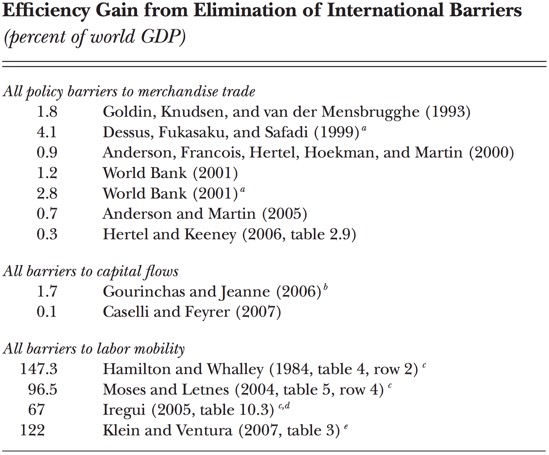Migration in the EU and its economic impacts
By Julian di Giovani
Professor di Giovani continued the roundtable with a presentation on the theme of migration in the EU. He first articulated it around a thorough analysis of the current situation and the data. Even if inflows massively increased in 2015 due to the refugee crisis, migration in the EU is not not new and deals with various inflows coming from outside and inside the EU. Looking at historical data, migration to Europe has been a steady process since WWII and notably accelerated in 2006 after the significant extension of the European Union to ten countries, mostly in Eastern Europe. Contrary to what is usually expected, the proportion of foreigners in 2014 was similar in the US and in the largest European countries.
Research has been very active in breaking down and understanding the net economic impact of immigration, with an extensive literature on underlying economic variables. The first results from Borjas (1995) highlighted limited gains (to the tune of 0.1% of GDP) and even negative aggregate gains. Borjas found that overall gains were lower than net fiscal costs implying a transfer of wealth from nationals to immigrants. However, Borjas already added place for positive effects when the level of skills of immigrants was taken into account. Recent research has shown larger gains of immigration: Klein and Ventura (2007) through labour reallocation extension in a growth model; di Giovanni, Levchenko and Ortega (2015) in multicountry model that focuses on increased varieties and remittances. Another line of research summarized by Clemens (2011), noted that globalization was most successful in terms of economic gains with the mobility of the labour factor rather than that of capital and goods.

Source: “Economics and Emigration: Trillion-Dollar Bills on the Sidewalk?”, Clemens, M., Journal of Economic Perspectives, 2011
Ortega and Peri (2014) also found positive evidence in a cross-country analysis of income per person and predicted openness to migrants, with results driven by Total Factor Productivity due to diversity effects such as differentiated skills in labour force and increased innovation. Labour market outcomes are also addressed in de la Rica, Glitz and Ortega (2015) with the confirmation that migrants are more unemployed and paid less but also that countries are unequal in education level of their migrant populations. The direct question is then the distributional effects of these labour market outcomes for native workers. The first results are mixed: Borjas (2003) finds that immigration is responsible for large drop in unskilled wages in the US while Ottaviano and Peri (2012) establish the opposite in a model that allows imperfect substitution between immigrants and nationals with equal education and experience. Looking at the firm-level data in Germany, Dustmann and Glitz (2015) show that changes in the skill mix of local labor supply are mostly absorbed by adjustments within firms with changes in relative factor intensities as well as firms entering and exiting the market. Finally, net fiscal effects remain hard to estimate. Contrary to Borjas (1995), Dustmann and Frattini (2014) get a positive and substantial effect when exploiting micro data for the UK over 1995-2001.
Going forward, Professor di Giovanni insisted that migration is indeed a blessing for the European Union’s ageing population and can also facilitate the increase of female participation in the labour market. Innovative policy is of course needed but some solutions already exist, such as the EU Blue Card scheme for high-skills workers, and should be more developed to get results in the short run. But this also requires both institutional and social rigidities to be tackled as well as more resources: an appropriate policy reaction should go far beyond the migration issue only, which cannot be taken as an isolated issue.
References:
George J. Borjas, 1995. “The Economic Benefits from Immigration,” Journal of Economic Perspectives
George J. Borjas, 2003. “The Labor Demand Curve is Downward Sloping: Reexamining the Impact of Immigration on the Labor Market”, Quarterly of Journal Economics
Paul Klein, Gustavo J. Ventura, 2007. “TFP Differences and the Aggregate Effects of Labor Mobility in the Long Run” The B.E. Journal of Macroeconomics
Julian Giovanni & Andrei A. Levchenko & Francesc Ortega, 2015. “A Global View Of Cross-Border Migration,” Journal of the European Economic Association
Michael A. Clemens, 2011. “Economics and Emigration: Trillion-Dollar Bills on the Sidewalk?”, Journal of Economic Perspectives
Francesc Ortega, Giovanni Peri, 2014. “Openness and income: The roles of trade and migration”, Journal of International Economics
Gianmarco I. P. Ottaviano & Giovanni Peri, 2012. “Rethinking The Effect of Immigration On Wages,” Journal of the European Economic Association
Christian Dustmann & Albrecht Glitz, 2015. “How Do Industries and Firms Respond to Changes in Local Labor Supply?”, Journal of Labor Economics
Christian Dustmann & Tommaso Frattini, 2014. “The Fiscal Effects of Immigration to the UK”, Economic Journal
